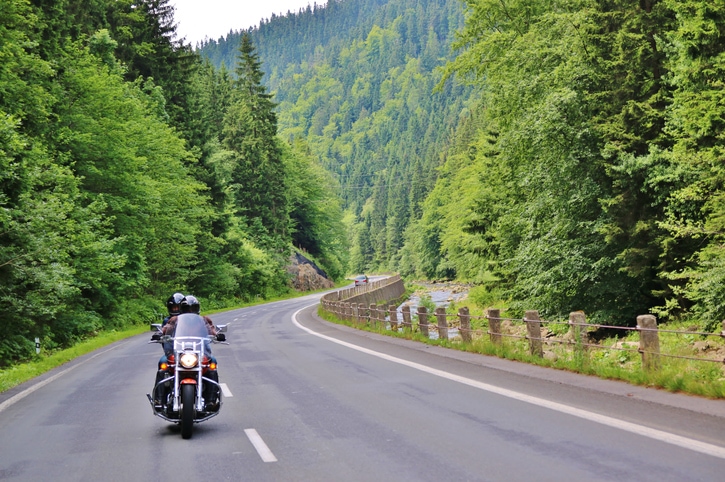How to avoid 10 common motorcycle accidents

July 29, 2019. According to The Globe and Mail, motorcycles are 15 times more likely to be involved in a collision than cars and one in 10 traffic fatalities involves a motorcycle. Motorcyclists are especially vulnerable because they are difficult for other drivers to see and are travelling at the same speed without the protection of a metal frame in case of a collision. But they also have powerful brakes, great handling, grippy tires, and unobstructed vision. You can use these to your advantage by learning how to handle the most common scenarios that cause collisions.
1. A car makes a left turn in front of you
The most common cause of motorcycle accidents is a driver making a left turn in front of a rider. Drivers may be distracted, may misjudge your speed, or can fail to see you.
What you can do:
- Look for cars waiting to turn.
- Look for gaps in traffic. Vehicles could be about to come through a gap even if you cannot see them now.
- Determine the threat level by considering whether a driver can see you, is looking at you, how fast they are moving, what direction their wheels are pointing in, and where they are on the road.
- Look for wheels moving; that is the first way you can tell that a car is starting to move.
- Be aware of everything else that is going on around you and plan out escape routes. Consider other traffic and road conditions.
- Your best chance of minimizing an impact is reducing your speed as much as possible and you can do this best using both brakes with the bike upright.
2. Slippery roads
Rain makes surfaces like manhole covers slick and makes oil come up out of the road in addition to making the road surface slippery. It limits visibility for other drivers, who often do not increase their following distance or brake earlier.
What you can do:
- Avoid riding in the rain or wait at least an hour for the oil to get washed away.
- Drive smoothly.
- Make sure you have proper tires on your bike.
3. Turning corners
Corners can be dangerous for riders because it can be difficult to correct your course if you misjudge how tight a turn is. You can also lose control when you hit a patch of gravel, sand, or water. If you do crash, there is an additional risk of being hit by other vehicles.
What you can do:
- Enter corners at a speed that lets you react to hazards.
- Pay attention to signs.
- Be aware of areas where gravel can collect.
- If you take a turn too fast, do not panic and slam on the brakes. Stay calm, keep your eyes where you want the bike to go, and lean into the turn.
4. Changing lanes
A car merging into your lane can be dangerous because you can easily be in a driver’s blind spot or they might not be paying attention.
What you can do:
- Look for signs that a driver is changing lanes, like turn signals, wheels turning, and a driver checking their mirrors.
5. Speed
High-performance motorcycles are involved in a disproportionate number of motorcycle accidents. They can go up to 160 mph and are most popular with people under 30, who are statistically less safe drivers than people over 30.
What you can do:
- Drive at a safe speed. Speed is a major factor in determining the seriousness of a collision and can be the difference between life and death.
6. Head-on collisions with cars
Head-on collisions with cars are incredibly dangerous for motorcycle riders because they usually happen at high speeds and riders have little protection.
What you can do:
- Be proactive and pay attention to the road ahead and hazards around you.
- If you notice a driver not paying attention or driving erratically, reduce your speed to lessen a potential impact.
- Stay in the right lane of a 4-lane road or on the right side of the lane on a 2-lane road.
- Drive off the road on the right side to avoid a collision.
7. Lane splitting
Lane splitting is when a motorcycle drives between two lanes of stopped traffic to get out of a traffic jam. It is dangerous because of a motorcycle’s proximity to cars and limited space to maneuver. Drivers also do not anticipate that anyone will be passing them.
What you can do:
- Avoid lane splitting because of the danger and because it is illegal in Alberta.
8. Getting rear ended
What is a fender bender for a car can easily be fatal for a motorcycle rider.
What you can do:
- If a car is stopped at a red light you can pull in front of it so it can act as a crumple zone between you and moving vehicles.
- Stop to the side of a lane instead of the middle of it so you can get out of the way.
- Be extra aware when visibility is bad, when stops can be unexpected, and at times when there might be drunk drivers on the road.
9. Locking your front brake
If you apply the front brake too hard it will lock and can cause you to lose control.
What you can do:
- Learn how to use your brakes by practicing in a parking lot.
- Get a bike with ABS and apply the brake as hard as you can in an emergency.
10. Intoxication
Riding a motorcycle drunk is obviously extremely dangerous and is a common cause of accidents and fatalities. Do not ride if you have had a few drinks.
Following these tips and staying aware of the road around you will help you avoid dangerous situations.



.jpg?300x300)